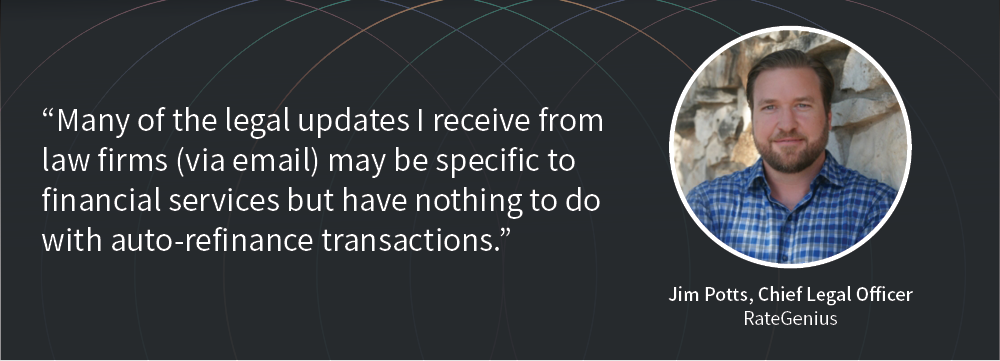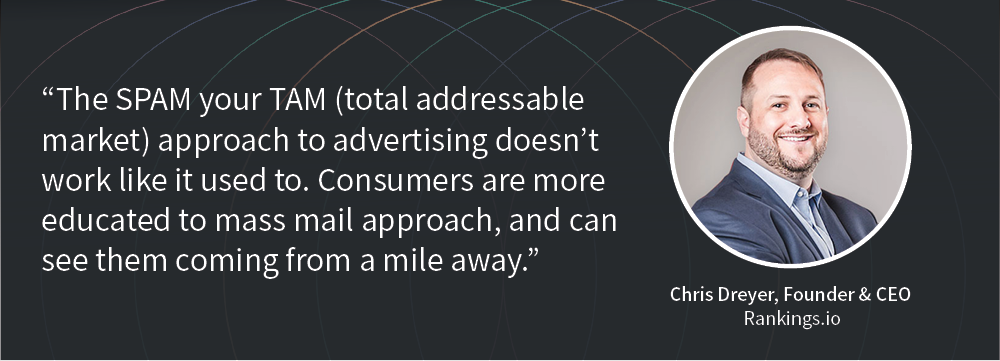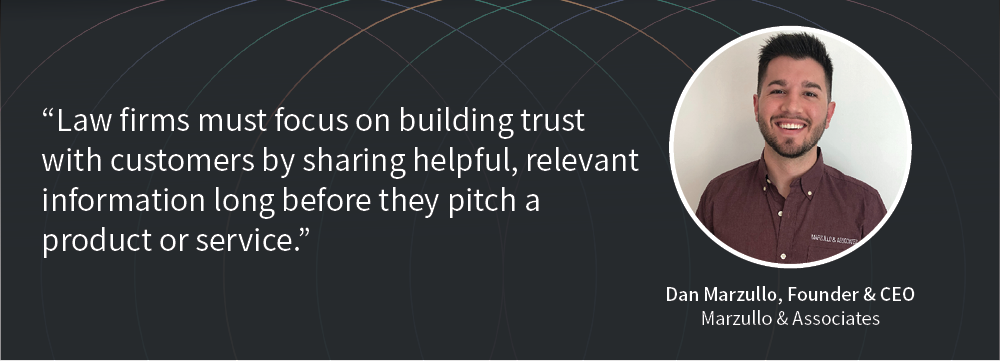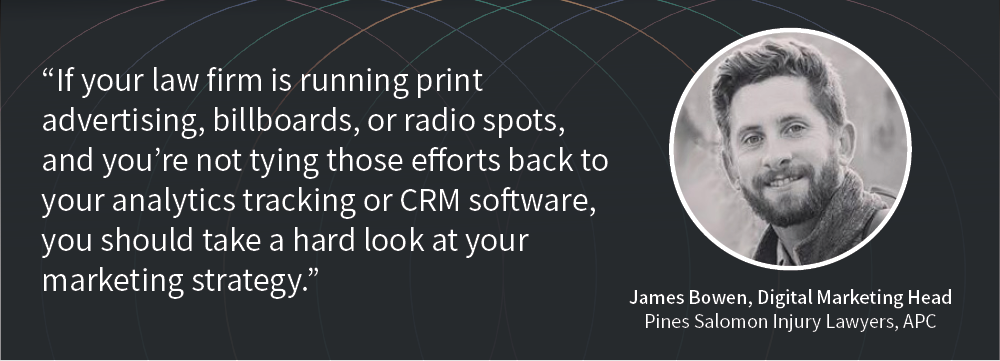Generating law firm marketing ideas can feel like throwing a plate of spaghetti against a wall and hoping that a noodle or two might stick.
At its best, spaghetti marketing wastes ad spend on unqualified impressions. At worst, you risk turning off your audience by reaching them at the wrong time and the wrong place with the wrong message.
Law firm marketing experts say there’s a better way.
More isn’t always better
When your law firm’s marketing goals feel stagnant, the natural temptation is to spend more to expand your reach. If you can reach more people, you’ll get more clients—but you may also pay for a lot of unqualified impressions.
A more effective strategy is to focus on converting more prospects from your existing spend.
One way to do this? Don’t send the same message to every person. Segmenting your audiences and personalizing your messaging is a powerful tool to get more out of the prospects you’re paying to generate.
Your email list is a precious asset that can do a lot of heavy lifting when converting a prospect to a client. Experts recommend focused, personalized newsletters to people within your target audience.
“Many of the legal updates I receive from law firms (via email) may be specific to financial services but have nothing to do with auto-refinance transactions,” said Jim Potts, chief legal officer at RateGenius.
An email strategy with specificity and personalization at the forefront is a more effective way to maximize conversions. Nuance matters here: RateGenius is a leader in auto-loan refinancing, but that doesn’t mean all financial services are relevant to their business. Law firms targeting businesses like RateGenius would see more success with a newsletter specifically devoted to auto loan financing.
Here’s a similar law firm marketing idea from another practice area: firms specializing in personal injury practice areas might have one newsletter focused on auto accidents and another for worker’s compensation. Both fall under the personal injury umbrella, but the reason for seeking legal representation differs quite a bit in each case. Your newsletters should be similarly personalized.
Don’t spam your TAM
In the legal-advertising space, the thinking is often that reaching more potential clients by casting a wide net leads to more business. But Chris Dreyer, founder and CEO of Rankings.io, is skeptical of this approach.
“The SPAM your TAM (total addressable market) approach to advertising doesn’t work like it used to. Consumers are more educated to mass mail approach, and can see them coming from a mile away,” Dreyer said.
With SPAM your TAM, you’ll probably generate some new business—but you’ll also pay to reach a lot of people who don’t fit within your client base.

(Source)
Even if you do reach qualified prospects, they might not be amenable to your message if you’re reaching them via traditional advertising, such as direct mail or billboards.
Dan Marzullo, founder and CEO of Marzullo and Associates, said, “When it comes to finding information about brands and services, consumers consistently rank traditional advertising as the least trusted format, and friends and family as the most trusted format.”
Deepen relationships within your target audience by solving their needs before you pitch your services. This helpfulness fosters the trust you need to sign a new client.
“Law firms must focus on building trust with customers by sharing helpful, relevant information long before they pitch a product or service,” Marzullo said.
And when it comes to providing useful information, content marketing shines.
Use content to solve problems at the right time
Marketing isn’t about shouting a brand’s message into the void; it’s about filling a specific user’s needs at the right time.
Fortman Law, which specializes in franchise law, leveraged a clever blend of content marketing and Google Ads to attract Spanish speakers who wanted to buy a cleaning franchise.
Rease Kirchner, a former Fortman Law employee, said, “I originally started with cleaning franchises because they target Spanish speakers, so I also wrote blogs and published ads in Spanish. I called out bad franchises by name and explained how they misled franchisees and end up profiting more off of failed franchises than successful ones.”
They experimented with targeting franchise names on Google Ads and driving traffic to their franchise consultations landing pages. Kirchner was able to outrank many of the franchises' home pages with this strategy. People researching a franchise with Spanish queries would see Fortman Law's exposé-style post before the franchise's own website.
Not sure which content to create? The best place to start generating law firm marketing ideas is your own data. A data-driven approach to content marketing will help your firm stand out from the noise.
“Creating good content is nothing new, but using data to inform on that content is a newer strategy for many legal firms,” said BJ Enoch, director of digital marketing at Opendorse.
Look for content with a high number of impressions but a low average position and a low number of clicks. Those are posts that have potential but aren’t ranking as well as they could and are not sending much qualified traffic to your site.
Find themes within the posts that have potential, and approach edits using the hub-and-spoke model for content marketing.
Think of your longer, more comprehensive content as the “hub” with adjacent, shorter topics to form the “spokes,” and internally link between the two. Writing multiple pieces of content within the same theme and linking them together serves as an index to demonstrate your expertise in that area.
Done well, the hub-and-spoke model helps you rank on the right search engine results pages and helps prospective clients find what they need quickly.
Tell stories about your firm’s impact
Elephant in the room: legal-marketing content can be a little bit . . . dry. A thousand-word resource about the intricacies of medical malpractice might be a great way to rank for a target keyword, but it’s also going to make a prospective client’s eyes glaze over.
Instead of drowning a reader in details, focus your content on the impact your firm has on clients. Be specific—tell real, inspiring stories of relevant cases to the practice area you’re targeting.
“People are more likely to engage with content that leverages storytelling,” Marzullo said. “People want to be inspired, educated, and uplifted when they browse social media or search for an answer to their question. Legal firms must meet this demand by telling stories not about what they do but about how what they do makes an impact on people's lives.”
(Source)
Consider supporting your site content and paid advertising with a social strategy that leverages storytelling. Posting customer testimonials on social media outlets like Instagram and Facebook is an effective way to tell stories that are engaging, not dry.
Resist the spend spiral with these law firm marketing ideas
When it comes to paid legal ads, it’s hard to know which impressions are worth paying for in the first place. James Bowen, head of digital marketing for Pines Salomon Injury Lawyers, APC, recommended fine-tuning your tracking before making decisions—especially for tricky-to-measure initiatives.
“If your law firm is running print advertising, billboards, or radio spots, and you're not tying those efforts back to your analytics tracking or CRM software, you should take a hard look at your marketing strategy,” Bowen said.
Paid advertising is a powerful tool, but buying more ads doesn’t necessarily mean you’ll generate more clients. Don’t let your marketing efforts stop with advertising; if you’re ready to grow, focus on getting more out of your existing ad spend.
The experts we interviewed are confident that law firms can leverage data to do that. Armed with information about what’s working for you already, you’ll be able to focus on segmentation, personalization, and storytelling to sign more clients without spending more money on ads.
CallRail can also help. Our Call and Form Tracking help you keep track of why some leads turn into clients and others don’t. These are the insights law firms need to create compelling marketing campaigns and resist the spiral of ineffective ad spend.


















